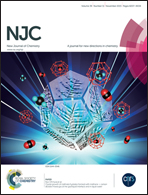Exploring the high k dielectric behavior of bio-carbon reinforced cyanate ester nanocomposites
Abstract
In the present work, the surface of bio-carbon (AC) derived from rice husks has been functionalized with 3-aminopropytriethoxysilane. The functionalized bio-carbon (FAC) was then used as a reinforcement for a cyanate ester (CE) matrix to obtain FAC/CE bio-composites. The morphology, thermal, electrical conductivity, and dielectric properties of the FAC/CE bio-composites were studied with respect to the FAC loading. It was found that the introduction of FAC reduces the heat-release rate and increases the degradation temperature, consequently the char residue of the cyanate ester matrix increases. The glass-transition temperature (Tg) obtained infers that the introduction of FAC increases the Tg of the resulting nanocomposites through restricting the mobility of the CE matrix. Moreover, FAC reinforcement improves the overall conductivity and acts as a capacitor in the resulting nanocomposites. Finally, due to its higher capacitive behavior the overall dielectric constant of the developed FAC/CE nanocomposites increased significantly and shows the highest value of the dielectric constant (k = 8.13) for a 4 wt% FAC/CE nanocomposite. The results from thermal and dielectric studies infer that the bio-carbon reinforced CE nanocomposites can be used as embedded capacitors in the interlayers of printed circuit boards (PCBs) and as an electromagnetic interference shielding/antistatic material.


 Please wait while we load your content...
Please wait while we load your content...